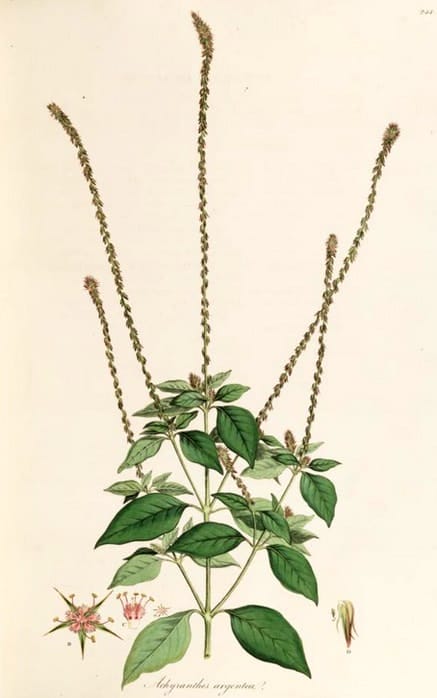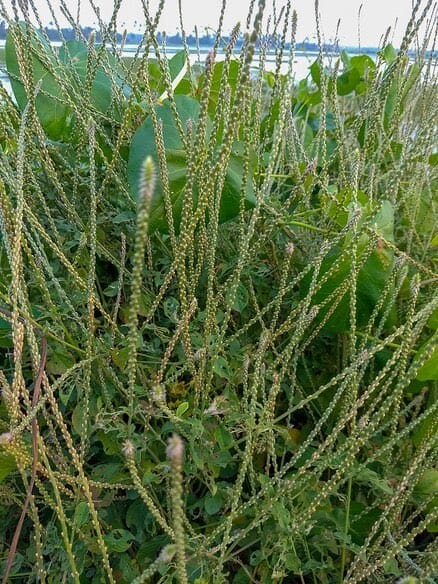Achyranthes, Niu Xi 牛膝Prickly Chaff flowerNiu Xi, or Huai Niu Xi (TCM) Apamarga, Chirchita (A. aspera, Ayurveda) Shveta Apamarga (A. bidentata, Ayurveda) Nayuruvi (Siddha) Chirchita (Unani) |

|

|
 Achyranthers aspera
Achyranthers asperaSibthrop & Smith, Flora Graeca, 1819
 Achyranthes aspera
Achyranthes aspera(Photo by Renjusplace) (Wikimedia)
Botanical name:
Achyranthes spp.
Two varieties are known:
- A. bidentata–Niu Xi, Apamarga
- A. aspera (syn. A. argentea, A. indica), A. longifolia–Tu Niu Xi, Shveta Apamarga
Another type of Niu Xi is supplied by Cyathula spp. and is called Chuan Niu Xi.
Parts used:
Root; also Leaf and Seed
Ashes of the whole plant are used for Stones in Ayurveda
Temperature & Taste:
Neutral. Bitter, Sour
Classification:
k. Medicines that Move the Blood
Uses:
A. bidentata (Niu Xi)
1. Moves the Blood, Clears Stasis: (TCM, Ayurveda)
-Amenorrhea, Dysmenorrhea
-retention of Afterbirth
-Pain from Trauma, especially of the joints
-High Cholesterol (Ayurveda)
2. Tonifies Liver and Kidneys, Strengthens Bones and Joints: (TCM, Ayurveda)
-weakness and pain of the Lower back and Knees
-used in formula to strengthen Memory in Ayurveda
-Threatened Miscarriage (Ayurveda)
3. Clears Heat, Guides Liver Yang Down: (TCM)
-Liver Yang rising up causing nosebleed, bleeding gums, headache, dizziness
-Yin deficiency with rising Heat
-hypertension, hemicrania (Ayurveda)
-hemostatic (Ayurveda)
4. Clears Damp-Heat in the Lower Abdomen: (TCM, Ayurveda)
-Painful or obstructed Urination
A. aspera (Tu Niu Xi, Shveta Apamarga)
1. Clears Heat, Resolves Toxin: (TCM, Ayurveda)
-swollen sore, painful throat; Tonsilitis, Diphtheria (TCM)
-Abscesses, Boils, Toxic Sores (TCM); Skin diseases (Ayurveda)
-Snake Bite, Rabid Dog Bite (TCM, Ayurveda)
2. Moves the Blood, Clears Stasis: (TCM, Ayurveda)
-Amenorrhea, Dysmenorrhea
-promotes Childbirth, used as an abortifacient and as Contraception (India)
3. Clears Damp-Heat in the Lower Abdomen: (TCM, Ayurveda)
-Painful or obstructed Urination
-Stones, with painful or bloody urination (whole plant ashed is used in India)
-Leukorrhea
-diuretic in Edema and Ascites (Ayurveda)
-used for cholesterol and Obesity
4. Promotes Vomit: (TCM, Ayurveda)
-emetic in large doses
5. Externally:
-ash is applied to bleeding piles
SALT OF ACHYRANTHES ASPERA (APAMARGA):
-Indigestion, Abdominal pain, Abdominal masses
-Gastroenteritis with pain
-Gravel, Stones
-Asthma
Comment:
1. A. bidentata (Niu Xi) is used in TCM, A. aspera (Apamarga) is used in Ayurveda. Both are synonymous as the latter is used as a local variety of Niu Xi in TCM (Bensky).
2. The roots of both varieties are used similarly. Achyranthes bidentata Niu Xi is farmed, with a larger root, and is a stronger tonic. Achyranthes aspera Apamarga (Tu Niu Xi) is wild-crafted, with a smaller root, and is better to clear Heat and Toxin. However, both varieties are similar and may substitute one another with the exception that Tu Niu Xi (wild sourced root) is not regarded as tonifying in TCM (Bensky).
Dose:
Decoction: 5–10 grams (up to 15 grams) in decoction;
Powder: 1–3 grams
The ash is used in Ayurveda in doses of 500mg–2 grams (some recommend a tablespoonful for Stones)
The Salt extracted from the ashes is given in doses of 125–500mg daily in divided doses.
Preparation:
1. Dry-Fried Achyranthes
The sliced root is dry fried until it swells and yellows a little. This makes it warmer and enhances the tonifying effect.
2. Wine-Fried Achyranthes:
The root is sprinkled with rice wine and left to absorb the alcohol. It is then stir-fried to lightly scorched and dried. This strengthens the Blood moving effect and is better for pain and obstruction of the channels, and for menstrual disorders.
3. Salt-Fried Achyranthes:
The dried root is soaked in salted water for a short time, then stir-fried until dry.. This is better to strengthen the Kidneys and nourish the sinews and bones, for lower back and leg pain and weakness.
4. Charred Achyranthes:
The roots are dry fried (often with a little water or wine) until scorched on the exterior and yellow on the interior. This eliminates its moist nature and is useful for Fire blazing upward causing toothache and bleeding gums.
5. Ashes of Achyranthes:
The herb burnt to ashes is used in Ayurveda. Ashes of the root is taken with Honey for Cough. Ashes of the whole plant is used for Edema
Corrective:
1. Long Pepper
2. Honey (Unani)
Substitute:
Cyathula Chuan Niu Xi
Main Combinations:
ACHYRANTHES NIU XI:
1. Lower Back Pain and weakness:
i. and Sciatica, Achyranthes Niu Xi with Eucommia Du Zhong
ii. with leg weakness or disc degeneration, Achyranthes Niu Xi with Velvet Deer Horn (Lu Rong)
2. Numbness and stiffness of the limbs from Kidney and Liver deficiency, Achyranthes Niu Xi with Polygonum He Shou Wu, Dang Gui, Eucommia Du Zhong, Lycium Gou Qi Zi, Cornus Shan Zhu Yu, Velvet Deer Horn (Lu Rong)
3. Arthritis, Rheumatoid Arthritis, Osteoarthritis, Degenerative Arthritis, Achyranthes Niu Xi with Asarum (Xi Xin), Saposhnikovia Fang Feng, Mistletoe (Sang Ji Sheng), Eucommia Du Zhong, Rehmannia Shu Di Huang, Dang Gui, Honey-fried Licorice (Zhi Gan Cao), Cinnamon (as in Da Ying Jian)
4. Atrophy, weakness and pain of the lower limbs from Damp Heat, Achyranthes Niu Xi with Coix Yi Yi Ren, Atractylodes Cang Zhu, Phellodendron Huang Bai (as in Si Miao Wan)
5. Blood stasis in the chest and upper body, Achyranthes Niu Xi with Dang Gui, Ligusticum Chuan Xiong, Safflower (Hong Hua), Peach kernel (Tao Ren), Bitter Orange Zhi Ke (as in Xue Fu Zhu Yu Tang)
6. Amenorrhea, Dysmenorrhea:
i. Achyranthes Niu Xi with Dang Gui and Safflower
ii. Achyranthes Niu Xi with Dang Gui, Ligusticum Chuan Xiong, Peony (Bai Shao), Cyperus Xiang Fu, Salvia Dan Shen (as in Jing Qian Fang)
iii. Late or Scanty Menstruation with clotting and pain, Achyranthes Niu Xi with Rehmannia Shu Di Huang, Honey-fried Licorice (Zhi Gan Cao), Cinnamon (as in Da Ying Jian)
7. Vertigo, Dizziness, Tinnitus:
i. Achyranthes Niu Xi with Mistletoe (Sang Ji Sheng)
ii. Achyranthes Niu Xi with Peony (Bai Shao), Fossil Bones (Long Gu), Oyster Shell (Mu Li), Hematite (Dai Zhe Shi) (as in Jian Ling Tang)
8. Toothache from Stomach Fire with Yin deficiency, Achyranthes Niu Xi with Rehmannia Shu Di Huang, Ophiopogon Mai Men Dong, Anemarrhena Zhi Mu (as in Yu Nu Jian)
9. Edema, Dysuria, Achyranthes Niu Xi with Plantain seed (Che Qian Zi), Water Plantain (Ze Xie)
ACHYRANTHES APAMARGA:
1. Strengthen memory, Achyranthes Apamarga, Convolvulus Shankapushpi, Coleus, Embelia, Calamus, Costus, Chebula (Ayurveda)
2. Threatened Miscarriage, Achyranthes Apamarga, Asparagus Shatavari, Madder, Sesame seed, decocted in Milk (Ayurveda)
3. Tinnitus and Deafness, Achyranthes Apamarga ashes (1 part), alkaline water prepared from the ashes of Achyranthes Apamarga (16 parts), Sesame Oil (4 parts), boil together to form an oil to be dropped into the ears. (Ayurveda)
Major Formulas:
Da Ying Jian
Du Huo Ji Sheng Tang
Feng Shi Ma Qian Pian
Jian Ling Tang
Jing Qian Fang
Qi Bao Mei Ran Dan
Shen Tong Zhu Yu Tang
Si Miao Wan
Xue Fu Zhu Yu Tang
Yu Nu Jian
Zhen Gan Xi Feng Tang
Cautions:
1. Not used during Pregnancy
2. Not used in excessive Menstruation
3. Suppresses appetite in some people (which is negated by applying its correctors).
Main Preparations used:
-
Extra Info
- Research
